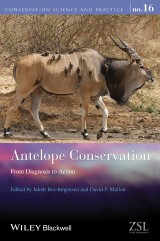Details
Antelope Conservation
From Diagnosis to ActionConservation Science and Practice 1. Aufl.
|
57,99 € |
|
| Verlag: | Wiley-Blackwell |
| Format: | EPUB |
| Veröffentl.: | 08.06.2016 |
| ISBN/EAN: | 9781118409626 |
| Sprache: | englisch |
| Anzahl Seiten: | 376 |
DRM-geschütztes eBook, Sie benötigen z.B. Adobe Digital Editions und eine Adobe ID zum Lesen.
Beschreibungen
Antelopes constitute a fundamental part of ecosystems throughout Africa and Asia where they act as habitat architects, dispersers of seeds, and prey for large carnivores. The fascication they hold in the human mind is evident from prehistoric rock paintings and ancient Egyptian art to today's wildlife documentaries and popularity in zoos. In recent years, however, the spectacular herds of the past have been decimated or extripated over wide areas in the wilds, and urgent conservation action is needed to preserve this world heritage for generations to come.<br /><br />As the first book dedicated to antelope conservation, this volume sets out to diagnose the causes of the drastic declines in antelope biodiversity and on this basis identify the most effective points of action. In doing so, the book covers central issues in the current conservation debate, especially related to the management of overexploitation, habitat fragmentation, disease transmission, climate change, populations genetics, and reintroductions. The contributions are authored by world-leading experts in the field, and the book is a useful resource to conservation scientists and practitioners, researchers, and students in related disciplines as well as interested lay people.
<p>Contributors vii</p> <p>Preface and Acknowledgements x</p> <p>Foreword xiii<br /><i>Richard D. Estes</i></p> <p>1 Our Antelope Heritage – Why the Fuss? 1<br /><i>Jakob Bro-Jørgensen</i></p> <p>2 Conservation Challenges Facing African Savanna Ecosystems 11<br /><i>Adam T. Ford, John M. Fryxell, and Anthony R. E. Sinclair</i></p> <p>3 Population Regulation and Climate Change: The Future of Africa’s Antelope 32<br /><i>J. Grant C. Hopcraft</i></p> <p>4 Interspecific Resource Competition in Antelopes: Search for Evidence 51<br /><i>Herbert H. T. Prins</i></p> <p>5 Importance of Antelope Bushmeat Consumption in African Wet and Moist Tropical Forests 78<br /><i>John E. Fa</i></p> <p>6 Opportunities and Pitfalls in Realising the Potential Contribution of Trophy Hunting to Antelope Conservation 92<br /><i>Nils Bunnefeld and E. J. Milner-Gulland</i></p> <p>7 Antelope Diseases – the Good, the Bad and the Ugly 108<br /><i>Richard Kock, Philippe Chardonnet, and Claire Risley</i></p> <p>8 Hands-on Approaches to Managing Antelopes and their Ecosystems: A South African Perspective 137<br /><i>Michael H. Knight, Peter Novellie, Stephen</i> <i>Holness, Jacobus du Toit, Sam Ferreira, Markus Hofmeyr, Christina Grant, Marna Herbst, and Angela Gaylard</i></p> <p>9 DNA in the Conservation and Management of African Antelope 162<br /><i>Eline D. Lorenzen</i></p> <p>10 Biological Conservation Founded on Landscape Genetics: The Case of the Endangered Mountain Nyala in the Southern Highlands of Ethiopia 172<br /><i>Anagaw Atickem, Eli K. Rueness, Leif E. Loe, and Nils C. Stenseth</i></p> <p>11 The Use of Camera-Traps to Monitor Forest Antelope Species 190<br /><i>Rajan Amin, Andrew E. Bowkett, and Tim Wacher</i></p> <p>12 Reintroduction as an Antelope Conservation Solution 217<br /><i>Mark R. Stanley Price</i></p> <p>13 Desert Antelopes on the Brink: How Resilient is the Sahelo-Saharan Ecosystem? 253<br /><i>John Newby, Tim Wacher, Sarah M. Durant, Nathalie Pettorelli, and Tania Gilbert</i></p> <p>14 The Fall and Rise of the Scimitar-Horned Oryx: A Case Study of Ex-Situ Conservation and Reintroduction in Practice 280<br /><i>Tim Woodfine and Tania Gilbert</i></p> <p>15 Two Decades of Saiga Antelope Research: What have we Learnt? 297<br /><i>E. J. Milner-Gulland and Navinder J. Singh</i></p> <p>16 Synthesis: Antelope Conservation – Realising the Potential 315<br /><i>Jakob Bro-Jørgensen</i></p> <p>Appendix: IUCN Red List Status of Antelope Species April 2016 329</p> <p>Index 332</p>
<p><b>Jakob Bro-Jorgensen</b>, Department of Evolution, Ecology and Behaviour, University of Liverpool, United Kingdom.</p> <p><b>David P. Mallon</b>, Division of Biology and Conservation Ecology, Manchester, Metropolitan University, United Kingdom.</p>
<p>Antelopes constitute a fundamental part of ecosystems throughout Africa and Asia where they act as habitat architects, dispersers of seeds, and prey for large carnivores. The fascination they hold in the human mind is evident from prehistoric rock paintings and ancient Egyptian art to today's wildlife documentaries and popularity in zoos. In recent years, however, the spectacular herds of the past have been decimated or extripated over wide areas in the wild, and urgent conservation action is needed to preserve this world heritage for generations to come.</p> <p>As the first book dedicated to antelope conservation, this volume sets out to diagnose the causes of the drastic declines in antelope biodiversity and on this basis identify the most effective points of action. In doing so, the book covers central issues in the current conservation debate, especially related to the management of overexploitation, habitat fragmentation, disease transmission, climate change, population genetics, and reintroductions. The contributions are authored by world-leading experts in the field, and the book is a useful resource to conservation scientists and practitioners, researchers, and students in related disciplines as well as interested lay people.</p>


















